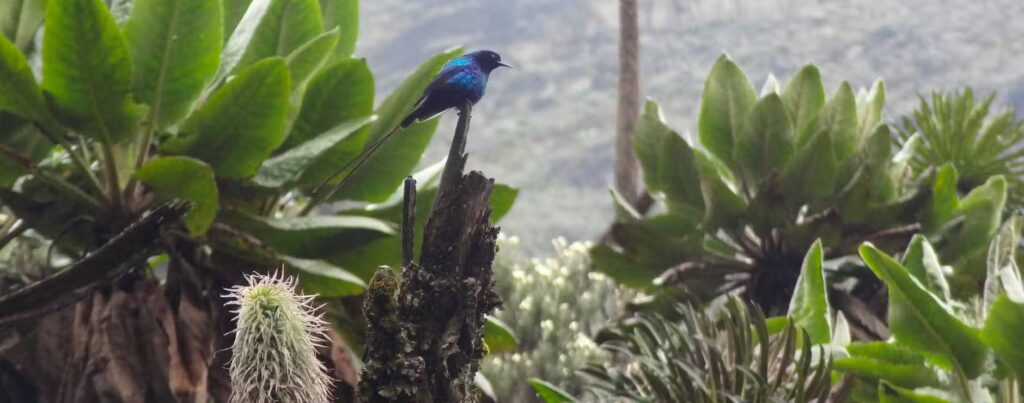What Animals are on Rwenzori Mountains?
What Animals are on Rwenzori Mountains?: The Rwenzori Mountains, sometimes referred to as the Mountains of the Moon, are situated close to the Uganda–Congo border in western Uganda. The lower slopes are covered with bamboo, moorland, and lush, moist montane forest, while the tropical snow summits feature Africa’s third-highest point.
A beautiful, fantasy-like scene is created as massive lobelias and “everlasting flowers” are scattered over the slope with massive tree heathers and multicolored mosses.

The highest reaches of the 120-kilometer-long and 65-kilometer-wide Rwenzori mountain range are preserved in Rwenzori Mountains National Park. In addition to some of the most exotic plants in the world, the park is home to 70 mammal species, 217 bird species, including 19 endemics of the Albertine Rift.
Which creatures inhabit the Rwenzori Mountains?
A wide variety of flower species are found naturally in the Rwenzori Mountains. Numerous biological zones can be found there, such as bamboo, heath, alpine meadows, snow, tropical rainforest, and African savanna. The base slopes of the Moon’s Rwenzori Mountains are dominated by savanna grassland, which is home to a wide variety of animals and fauna. Outside of the savanna zone, at elevations of 1676 and 2286 meters above sea level, is a rain forest.
When on a safari in the Rwenzori Mountains of Uganda, it is worthwhile to see a number of animal species. Among the 70 animal species that call the lower slopes home are elephants, bushbucks, duikers, hyrax, red-tailed, l’Hoest monkeys, black and white colobus monkeys, Angola colobus monkeys, and three-horned chameleons.
There are fewer larger animals in the mountains as a result of heavy hunting in the 1970s and 1980s. Although they are rarely seen, buffaloes and elephants can still be found in the wooded area. The creatures that are most frequently seen are chimpanzees, blue monkeys, Rwenzori Colobus monkeys, duiker, forest hog hyrax, and leopards. The leopard can be seen up to 4,000 meters above the ground.
217 bird species, including many endangered and Albertine rift species, may be found in the Rwenzori Mountains. Common species include Rwenzori Batis, Rwenzori Turcos, blue sunbirds, Archer’s robin chit, mountain buzzards, crimson wings, barred long-tailed cuckoo, slender-billed starling, handsome francolins, stripe breast tit, golden-winged sunbird, montane sooty boubou, and black and fast eagles.

What is essential knowledge about the Rwenzori Mountains?
A truly amazing and life-changing experience is climbing the magical Rwenzori Mountains. The best hiking experience is provided by the wide variety of plants and animals, as well as the many environments as you climb through several flora zones.
Unspoiled and unquestionably one of the world’s most alluring treks, this amazing and breathtaking walk has never been offered before. The bristly lichen dangling from massive heather and the valley of nine lakes, surrounded by granite cliffs, crags, and snow-capped mountaintops, are the breathtaking features of Rwenzori.
What to anticipate when ascending the Rwenzori Mountains?
You will traverse multiple vegetation altitudinal zones on a hike in the Rwenzori Mountains, each with its own distinct microclimate, flora, and fauna. With slopes ranging from 1,800 to 2,500 meters, the Afro-montane forest is the most varied. Dense thickets fill in the spaces left by large, established trees pushing to create a canopy.
Thick woods, with leaves covering the ground in a deep litter and blossoms blossoming only once every 30 years, gives way to bamboo stands between 2,500 and 3,000 meters above sea level. You enter the heather zone above this point and continue till you reach 4,000 meters. There are many usnea beard lichens and sphagnum moss, and the ground is dotted with coral pink orchids. Bog-wet valley bottoms are covered with large tussocks.
The massive groundsel, Senecio adnivalis, and the torch lobelia, Lobelia wollastonii, are found in the alpine zone, which is higher than 4,000 meters. The vegetation decreases to moss, lichen, and a few “Everlasting” plants after 4,300 meters. The plants that grow over 3,800 meters are part of some of the most mysterious botanical groups on the planet.
When visiting Rwenzori Mountains National Park, where should you stay?
The Rwenzori Turaco View Campsite, Ruboni Community Camp, Hotel Margherita, Equator Snow Lodges, and Katara Lodge are a few of the places where visitors to the national park can find lodging.
How can I travel to the National Park of the Rwenzori Mountains?
From Kampala to Kasese, there are two highways that lead to the Rwenzori Mountains National Park. The shortest route is the 300-kilometer trip from Kampala to Fort Portal via Mubende, and the longest is the 350-kilometer drive from Kampala to Masaka via Mbarara, Bushenyi, and Kasese.
To discover the distinctions between the Northern and Southern Hemispheres, the second route to Kasese includes an amazing layover close to the Equator.
The Rwenzori Mountains National Park can be reached by a 40-minute drive after a chartered flight from Entebbe International Airport to Kasese Airstrip.



